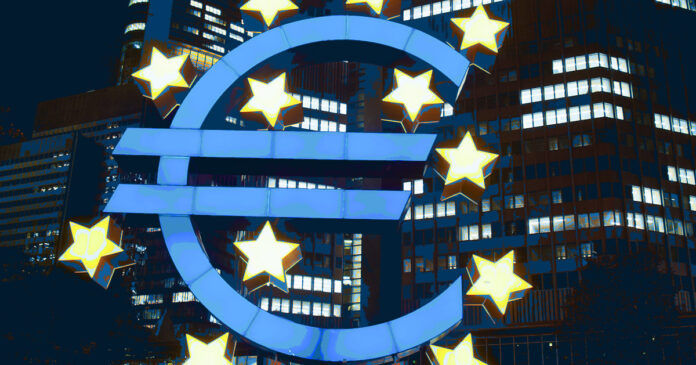
Piero Cipollone, a member of the European Central Bank’s (ECB) Executive Board, urged Europe to embrace digital assets and distributed ledger technology (DLT) to create an integrated capital markets union.
Speaking at the Bundesbank Symposium on the Future of Payments on Oct. 7, Cipollone outlined how digital technologies can reshape Europe’s fragmented financial system, reducing intermediation costs and improving market efficiency.
Fragmentation
Cipollone pointed out that Europe’s 35 different listing exchanges and 41 trading platforms contribute to an inefficient and divided financial landscape. He added that despite efforts like the TARGET2-Securities platform, which harmonizes securities settlements across the continent, regulatory barriers and inconsistent legislative frameworks continue to hinder integration.
Cipollone highlighted that without harmonized rules on asset custody, tax processes, and regulatory supervision, Europe remains unable to fully realize the synergies of a unified capital market. He added that this fragmentation makes European markets less competitive globally and called for accelerated efforts to align regulations across EU member states.
According to Cippollone:
“The lack of a unified supervision or a permanent safe asset has left Europe’s capital markets fragmented.”
The EU has made steps towards integration, but Cipollone argued that these efforts must intensify, particularly with the rise of digital assets. Tokenization, the process of issuing assets on distributed ledger technology (DLT), offers the opportunity to create a more efficient system from the start, bypassing traditional market inefficiencies.
Integrated market
Cipollone highlighted tokenization as a key driver of financial transformation, offering significant opportunities to improve liquidity and reduce transaction costs. Unlike conventional financial assets, digital assets on distributed ledgers do not rely on a central database but instead, operate on a synchronized network of decentralized traders.
According to Cippollone:
“This could mark the shift from centuries-old bookkeeping systems to a future of decentralized, real-time transactions.”
He also noted that over 60% of EU banks have begun exploring DLT solutions, with 22% actively using these applications. However, he further stated that the full potential of DLT remains untapped.
Cipollone urged public authorities to act swiftly to support the transition to digital markets and ensure that central bank money is a key settlement asset in this transformation. He proposed the creation of a European ledger, a shared platform where digital assets, central bank money, and commercial bank money coexist on interoperable systems.
This ledger would enable financial institutions, central securities depositories (CSDs), and market participants to provide services directly on a unified infrastructure, reducing barriers to entry and fostering capital market integration.
He also warned that failing to coordinate DLT adoption could further entrench existing fragmentation as individual countries and institutions develop isolated platforms. The ECB executive further called for closer collaboration between regulators, central banks, and market participants to ensure that Europe leads the way in building a unified digital capital market.
Cipollone added:
“The transformative potential of tokenization goes beyond efficiency. By acting now, we can shape an integrated financial ecosystem that will serve Europe’s markets well into the digital future.”
Credit: Source link






















 Bitcoin
Bitcoin  Ethereum
Ethereum  Tether
Tether  Solana
Solana  XRP
XRP  Dogecoin
Dogecoin  USDC
USDC  Lido Staked Ether
Lido Staked Ether  Cardano
Cardano  TRON
TRON  Avalanche
Avalanche  Shiba Inu
Shiba Inu  Wrapped stETH
Wrapped stETH  Wrapped Bitcoin
Wrapped Bitcoin  Toncoin
Toncoin  Sui
Sui  WETH
WETH  Bitcoin Cash
Bitcoin Cash  Chainlink
Chainlink  Pepe
Pepe  Polkadot
Polkadot  LEO Token
LEO Token  Stellar
Stellar  NEAR Protocol
NEAR Protocol  Litecoin
Litecoin  Aptos
Aptos  Wrapped eETH
Wrapped eETH  Uniswap
Uniswap  USDS
USDS  Cronos
Cronos  Hedera
Hedera  Internet Computer
Internet Computer  Ethereum Classic
Ethereum Classic  Bonk
Bonk  Bittensor
Bittensor  Render
Render  Ethena USDe
Ethena USDe  POL (ex-MATIC)
POL (ex-MATIC)  WhiteBIT Coin
WhiteBIT Coin  Dai
Dai  MANTRA
MANTRA  Artificial Superintelligence Alliance
Artificial Superintelligence Alliance  Arbitrum
Arbitrum  dogwifhat
dogwifhat  Monero
Monero  Stacks
Stacks  Filecoin
Filecoin  OKB
OKB 
